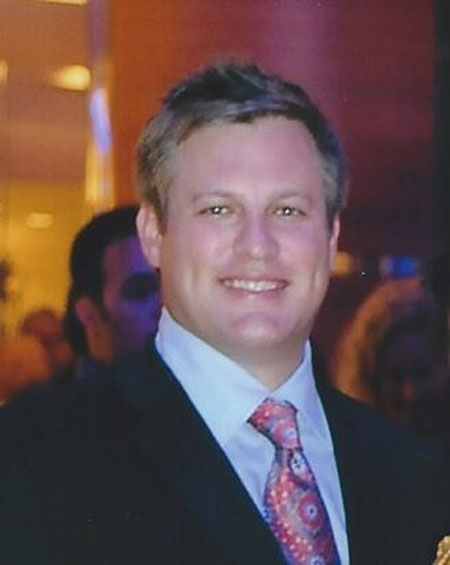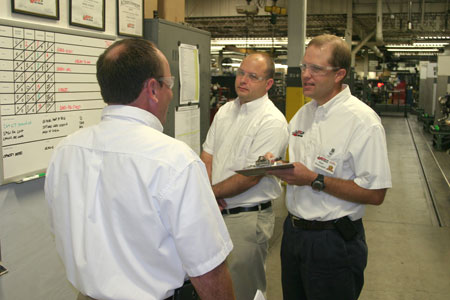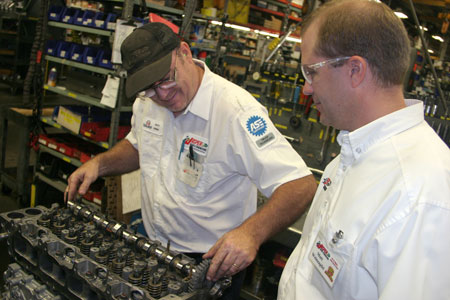With all of the talk of special interests, pork barrel spending and polarization, the political landscape across America seems hopelessly mired in rhetoric.
But while it may be politics as usual in Washington, DC, on the airwaves and at both of the major party conventions, constituents of the Production Engine Remanufacturers Association (PERA) will celebrate at peaceful transition of power this month at their annual gathering in Seattle, WA.
Engine Builder magazine recently discussed the State of the Association with incoming PERA President Robert McGraw and outgoing president Matt Weinzapfel. Both are young, dynamic leaders within their respective organizations (McGraw with AER Manufactur-ing in Carrolton, TX; and Weinzapfel with Jasper Engines and Transmissions in Jasper, IN).
Both have strong convictions on the future of this industry. While one is looking forward and the other is looking back, both are looking out for the best interests of the members of their association.
Robert McGraw Incoming PERA President
Robert McGraw, vice president of operations and COO of AER Manufacturing, brings to his tenure as PERA president a goal of continued strengthening of the association and its members in the industry. And despite his relatively youthful appearance, McGraw actually has decades of experience as a participant in Association activities.
“I actually have a history with PERA that goes back way before I worked at AER,” McGraw says. “I’ve been going to those meetings with my parents since I was young. I remember a long way back going to PERA when everybody used to bring their families.”
Rich in history and tradition, AER began operations in the early 1940s in the back of a local automobile dealership in Texas. With steel and iron supplies in short supply, and the country and production lines focused on WWII, Henry Ford sought ways to keep the automobile industry alive and cars and trucks running at home; the idea for remanufactured engines and engine parts was born.
Ford contracted trusted suppliers who could recycle and remanufacture crucial parts to Ford Motor Co. specifications. As a result, AER became one of the first Ford authorized engine remanufacturers in the country.
Under the leadership of Gordon McGraw, AER became the leader in remanufacturing and reassembling engines. He established AER’s continuing tradition of excellence, planning the growth of the company to provide a wide range of engine components and engine assemblies. Bob McGraw took over leadership of the company in 1974, and he continues to build his legacy today through Robert and Matt McGraw.
Today, AER is a relatively flat organization with few management tiers. The expertise of top executive management within the McGraw family, combined with a strong group of managers from across the organization, combine to make AER a leader in engine remanufacturing.
“My grandfather helped found this industry and it’s funny how the things that were important to him back then are still important now. For instance, he was obsessed with quality. And he was always looking for ways to use the latest tools and technology to do a better job at a better price. Even though engines are much more complex than they were in the ’40s when my grandfather started, we still do the same things he did – we obsess about quality and we explore every technological advantage that can make our engines better and our prices more competitive. In my career, I’ve seen this time and again.”
Today, AER offers nine variable production lines, which can run day and night, allowing for quick changes in production demands. The company has two Texas manufacturing facilities with state-of-the-art machining and assembly technologies and 11 strategically located distribution warehouses that provide cost-effective, timely delivery throughout the United States.
McGraw comes to his position with something of a pedigree of leadership, following in the footsteps of several other AER members who also served on the executive branch of PERA, including his father, Robert (1985) and Raymond Fink 1992 and 2006). McGraw says this legacy of leadership has helped him grow professionally, but so has time spent working in AER’s manufacturing facility.
“We heard all about the industry and the association while we were growing up,” says McGraw, “but my brother and I both worked in the factory during the summers when we were about 14. We worked regular hours; we worked in the factory tearing down engines, boxing, working in the warehouse, stocking shelves, pulling orders. We worked a couple months out of the summer – 40 hour weeks!”
McGraw says having a regular paycheck at that age was very convenient, but it gave him something even more useful – real world experience.
“I went down to SMU here in Dallas and got an advertising degree,” McGraw says. “I worked for another company after I graduated there in 2001. Finally, I think it was about early 2003, I came in and started my full time employment at AER.”
McGraw acknowledges that his youth may give him a slightly different perspective than some industry veterans, but he feels he brings a wealth of experience to the office.
“I was on a conference call recently and the subject came up about time in the industry – some of the participants explained that they’d been in the industry for 35 years. I was born in 1979!” he laughs. “But I do think one of the positive things I see is the increase in younger people. Matt (Weinzapfel) and myself, we’re just part of the Association’s next generation. We see a lot of younger engineers – let’s say some of the 30-somethings – who we’d like to get involved. We do see a younger crowd that is interested in attending events and really looking to keep PERA going in a positive direction.”
McGraw says one of his overriding goals is to continue to serve the entire industry. To that end, he has recently accepted a nomination to serve on the board of the Engine Rebuilders Council (ERC) of the Automotive Aftermarket Industry Association (AAIA), as well as on the board of directors of the Engine Builders Association (AERA).
“I’m really new to AERA, and I look forward to meeting some of the other people in the industry who aren’t involved with PERA. And it’s good to see, especially with AERA, some of what the other guys are seeing. We’re one of the big guys, and we have the chance to interact with guys who are running small shops. It’s really interesting to see what they do and how they operate,” says McGraw.
“I look forward to learning more. I really do. The more you know about your whole industry – from a small guy to the bigger guy to the salvage yard – the better off you’re going to be,” he says.
“It’s a little different scene now. Obviously, the market’s contracted some, but we still have a lot of solid people in PERA,” McGraw says. “It’s great to get with those guys and see how they’re doing and what they have going on in their worlds. We all hit different markets. Sometimes we help each other, sell each other a product somebody else may not have at the time. And it’s always been that way. I remember my dad telling me stories about when somebody had a problem at their plant and they needed some product and we would ship him product.”
While it’s a smaller organization now, McGraw contends that while this industry’s businesses are still competitors, there’s often a benefit to helping each other as much as needed to keep the industry strong. That mentality also exists to a degree between the industry groups.
“What we want to work toward is synergism,” he says. “If the different associations are able to work together to some degree, we will all be more successful than if all the associations practice a silo mentality,” he says.
“As I’ve worked in PERA, I’ve noticed a need in our industry to educate our customers about why remanufacturing is the best source for the engines they need and also to help everyone in our industry (and also those who buy from us) understand the achievement of the kind of quality we’re after really boils down to manufacturing excellence and a commitment to technology.
“At AER, we believe you have to give back – especially to the industry that has made us successful now for three generations. Besides, we helped START this industry. Of course we feel the responsibility to do what we can to make it as successful as possible. Involvement in the associations that support the remanufacturing industry is one way we do that.
“I think one way PERA could give back to the industry is to work to better educate our customers about how the products we sell excel in value, quality and environmentally-consciousness compared to the other options that are out there,” McGraw concludes.
Matt Weinzapfel Outgoing PERA President
Matt Weinzapfel, 40, vice president of engine manufacturing at Jasper Engines & Transmissions, also brought a sense of youth and legacy to his term in office when he became PERA president in 2010, following other Jasper leaders to the helm. He says, in an understated manner, that his tenure was a very “interesting couple of years.”
“The association has gone through so much change over the last five years,” he says, “that was reflected in the overall industry. We saw so many of the major players in the reman industry that either closed their doors or consolidated. So the association had to adjust along with that. With the realignment of the industry and the loss of membership due to that realignment of the industry we, as an association, as a board, had a lot of tough decisions.”
Weinzapfel says when he came into the presidency it became a question of focus: Where are things headed and what is our direction going to be?
“This decision actually started with Dave Steine’s presidency starting in around 2008 and then into mine,” Weinzapfel says. “First, we want to improve the knowledge of our membership. We can do that by improving technical knowledge on how to remanufacture an engine. In addition, what are we doing to improve our own manufacturing processes? We can get out and see what other remanufacturers are doing, what other supplier companies are doing with manufacturing.”
Weinzapfel says interaction with other shops helps with benchmarking, to see what others are doing differently or more efficiently. But it also provides something else.
“The second half, I think, of what the association stands for,” says Weinzapfel, “is a valuable networking opportunity. Since we’re down to one meeting a year, it’s that time of year when all the remans can get together. The supplier base can come in, and we’re all right there in close proximity for three days or however long the convention’s going to be. And we provide a lot of great opportunities through our receptions for people to network and get to know each other better. It’s all about improving knowledge and providing a forum for networking.”
Weinzapfel says that when he started through the PERA chairs he had a number of goals – each of which basically echo the goals of the industry.
“Determining our mission and becoming financially stable were important goals to me,” he says. “And yes, as we’ve made some tough decisions as an association, these are the same decisions we all make in our own businesses day-to-day. Times change and we need to adjust.”
Weinzapfel says he views association involvement as an opportunity and as a responsibility.
“I think it’s twofold. One, you should be involved because you want to learn and you want to have those industry contacts. Every year I go to conference I bring back some things that I can apply to my own business,” he says.
“In addition, I think, now more than ever we are all more closely tied together as remanufacturers. We’re all working toward making remanufacturing a viable alternative in the aftermarket. And the closer we all stay together and keep preaching that message to our own customer bases that this is a viable option, the better.
“The quality of the product is better now than it’s ever been. The parts that were put into these products are better now than they’ve ever been. Remanufacturing is the best alternative to re-power your vehicle. As a manufacturer we need to be involved, and we need to work with other folks in the industry to promote remanufacturing,” says Weinzapfel.
Industry evolution has meant that fierce competition has, to some degree, given way to a natural niche segmentation between the remaining remanufacturers, says Weinzapfel.
“For us, particularly, here at Jasper, a big part of our business is our distribution with all of our branch locations around the country, and our own trucking network, both for over-the-road and local delivery, and really focusing on those independent garages and fleets. Others have done things their own way,” Weinzapfel says.
“It’s all kind of evolved to where we all have a little bit different segment of the market. And I don’t know that any of us ever sat down and planned that, but there’s enough room out here for everybody that’s left. We just need to keep promoting re-manufacturing as a viable alternative in the aftermarket.”
Business has stayed relatively strong, Weinzapfel says, and he’s optimistic. “2010 and 2011 were fabulous years. 2012 has remained strong. And we’re optimistic about the whole remanufacturing industry and that we’re looking for growth, and not just to hang in there.”
Weinzapfel says his career in the remanufacturing industry and his history with Jasper are one and the same. As a Jasper native, he started with the company as a college intern while at the University of Evansville.
“I came on full-time right after I graduated and have been here ever since,” he explains. “I’ve had just phenomenal opportunities to be able to move around throughout our organization. I started out working with our distribution network, primarily our distribution branch locations around the country, did a little bit of auditing and accounting, and then moved into manufacturing when we opened our Crawford County manufacturing facility in 1998 and ‘99.
"I was plant manager there for five years and then rolled back to our Jasper, IN plant and was engine division manager – gas and diesel – for a number of years. I spent some time in our lean manufacturing group, Jasper production system group and back out to diesel manager for a while. I’m now vice president of engine manufacturing with responsibility over all of our engine manufacturing, both at our two Indiana plants and our Missouri plant."
Flexibility and an ability to adapt have been necessary for Weinzapfel professionally, he says, and it’s an attitude reflected in the current remanufacturing industry.
“There are a lot of resources out there that we can all take advantage of,” he says. “There’s a lot of support out there through the AAIA catalogs and things like that and there are a lot of ways to find information. And most of us larger players that are left specifically have research and development folks who are doing that work day-to-day. And as a new product comes out, we’re buying up as many examples of that product as we can, and getting it in, and dissecting it, and figuring out mode of failure, and trying to engineer better quality back in to the product than what the OE was able to put in to it.”
As he prepares to transition back to other responsibilities with PERA’s committees, Weinzapfel feels the industry is in good hands.
“Well, we do feel like we’re all going about it in slightly different ways and for slightly different reasons,” he says. “But the better the industry does and the better we do all of us together, I think, the better it’s going to be. So, we’re all working in the same direction.”
For more information about involvement with PERA, visit www.pera.org.















